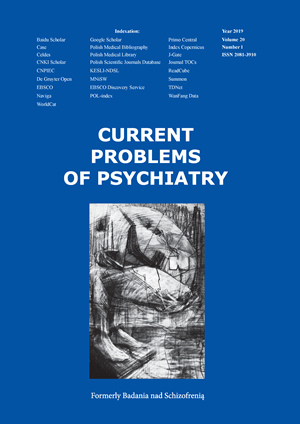Neurological disease or conversion disorder? Important aspects of differential diagnosis - psychiatric and psychotherapeutic perspective. Case report
DOI:
https://doi.org/10.2478/cpp-2019-0001Keywords:
conversion disorders, amyotrophic lateral sclerosis, differential diagnosisAbstract
Introduction: Amyotrophic lateral sclerosis is a progressive neurodegenerative disease with undetermined etiology. Due to diverse symptomatology, it requires a thorough differential diagnosis, with consideration of conversion disorders. The presented thesis describes a case of a young man hospitalized in the Department of Psychiatry in order to verify the possible psychogenic basis of his symptoms, which previously were considered to be a manifestation of neurological disease with an unfavorable prognosis.
Aim: The aim of the thesis is to raise the issue of a multidisciplinary approach to diagnostic process in medicine, as well as taking into account the legitimacy of including psychiatrists, psychologists, and psychotherapists in diagnostic teams.
Case study: We present a case report of a man who has been experiencing progressive feeling and walking problems for the past several years, which originally suggested a neurological or rheumatological disease. Earlier observations and medical tests had led to a diagnosis of amyotrophic lateral sclerosis. After several years, the diagnosis was excluded, and the patient was referred to the Department of Psychiatry to determine the possible psychogenic basis of his symptoms. Diagnostic methods used during the patient’s hospitalization confirmed the conversational nature of his symptoms, and both pharmacological and psychotherapeutic treatment caused reduction of severity of his symptoms and allowed him for a gradual return to independent functioning.
Conclusion: Analysis of the collected data, including patient’s life history and a course of his treatment, indicates the validity of a holistic approach to medical problems, which implies the inclusion of specialists in the field of psychiatry, psychology, as well as psychotherapists in diagnostic teams. Such a multidimensional view of the patient and the source of his symptoms may allow for faster diagnosis and may also contribute to reducing the risk of making mistakes such as an incorrect assessment of factors triggering the disease process.
References
1. Rubinowicz-Zasada M Orczyk A Orczyk M Pasek J. Stwardnienie boczne zanikowe – choroba neuronu ruchowego. Prezentacja przypadku. Pediatria i Medyc yna Rodzinna 2015;11(1): 112–118.
2. Nguyen H.P Van Broeckhoven C Van der Zee J. ALS genes in the genomic era and their implications for FTD. Trends Genet. 2018; 34(6): 404-423.
3. Hübner I Hübner J Witek I Kroczka S. Stwardnienie zanikowe boczne z objawami piramidowo – pozapiramidowymi oraz jako zespół paranowotworowy – opis dwóch przypadków. Polski Przegląd Neurologiczny 2017;13(3):137-143.
4. Wijesekera LC Leigh PN. A myotrophic lateral sclerosis. Orphanet J Rare Dis. 2009;4:3.
5. Kędra E Jaz AL. Jakość życia pacjentki wentylowanej mechanicznie w warunkach domowych z powodu stwardnienia bocznego zanikowego. Pielęgniarstwo i Zdrowie Publiczne 2013;3 (2): 155-165.
6. Kubiszewska J Kwieciński H. Stwardnienie boczne zanikowe. Sclerosis lateralis amyotrophica. Borgis – Postępy Nauk Medycznych 2010;6: 440-448.
7. Adamek D Tomik B. Stwardnienie Boczne Zanikowe. Wydanie I. Kraków; Wydawnictwo ZOZ Ośrodek UMEA Shinoda-Kuracejo: 2005.
8. Seligman M Walker E Rosenhan D. Psychopatologia. Poznań; Wydawnictwo Zysk i S-ka: 2003.
9. Pużyński S Wciórka J. Klasyfikacja zaburzeń psychicznych i zaburzeń zachowaniaw ICD-10. Opisy kliniczne i wskazówki diagnostyczne. Kraków – Warszawa; Uniwersyteckie Wydawnictwo Medyczne Vesalius: 2000.
10. Stefańska A Dziwota E Stefański M Nasiłowska-Barud A Olajossy M. Modern faces of hysteria or some of the dissociative disorders. Current Problems of Psychiatry 2016; 17(3): 214-225.
11. Gałecki P Święcicki Ł. Kryteria diagnostyczne z DSM-5. Desk Reference. Wrocław; Edra Urban & Partner: 2015.
12. Hłodzik K Dziwota E Karakuła-Juchnowicz H Olajossy M. Historia histerii i co dalej... Current Problems of Psychiatry 2016; 17(1): 31-37.
13. Dudzic-Koc A Szałkowska A. Rodzinne i osobowościowe uwarunkowania zaburzeń konwersyjnych – studium przypadku. Pielęgniarstwo Polskie 2015; 55: 99-104.
14. Araszkiewicz A. Zaburzenia dysocjacyjne. W: Pużyński S Rybakowski J Wciórka J red. Psychiatria. Tom 2: Psychiatria kliniczna. Wyd. II. Elsevier Urban & Partner: Wrocław 2011: 453-466.
15. Pawełczyk T Pawełczyk A Rabe-Jabłońska J. Zanim rozpoznasz u pacjenta zaburzenie konwersyjne zbadaj dokładnie jego stan somatyczny i neurologiczny. Opis przypadku. Psychiatria Polska 2012; 46 (3): 483-492.
16. Koziorowska-Gawron E Koszewicz M Budrewicz S Podemski R. Psychogenne zaburzenia chodu – opis trzech przypadków. Polski Przegląd Neurologiczny 2014;10(4): 169-173.
17. Kubiak K. Zaburzenia dysocjacyjne (konwersyjne) u młodego mężczyzny z cechami osobowości histrionicznej: opis przypadku. Postępy Psychiatrii i Neurologii 2000; 9 suplement 3 (11) : 103-107.
18. Stone J Carson A. Neurologiczne objawy czynnościowe: diagnostyka i postępowanie. Neurologia po Dyplomie 2012; 7(2): 35-47.
19. Voon V Lang AE. Antidepressant treatment outcomes of psychogenic movement disorder. J Clin Psychiatry 2005; 66 (12): 1529-1534.
20. LaFrance WC Jr Baird GL Barry JJ Blum AS Frank Webb A Keitner GI Machan JT Miller I Szaflarski JP. NES Treatment Trial (NEST-T) Consortium. Multicenter pilot treatment trial for psychogenic nonepileptic seizures: a randomized clinical trial. JAMA Psychiatry 2014; 71(9): 997-1005.
21. Bravo TP Hoffman-Snyder CR Wellik KE Martin KA Hoerth MT Demaerschalk BM Wingerchuk DM. The effect of selective serotonin reuptake inhibitors on the frequency of psychogenic nonepileptic seizures: a critically appraised topic. Neurologist. 2013; 19 (1): 30-33.
Downloads
Published
Issue
Section
License
Copyright (c) 2019 Authors

This work is licensed under a Creative Commons Attribution-NonCommercial-NoDerivatives 3.0 Unported License.


